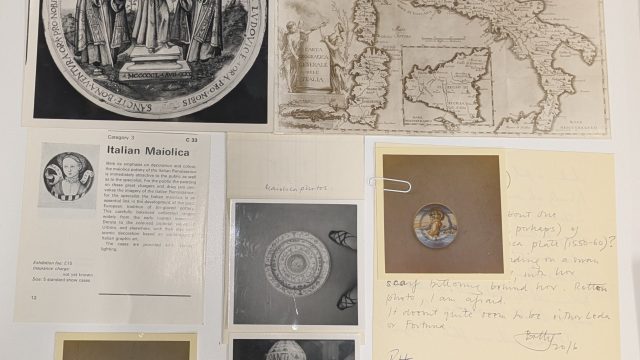As a student of the MA History of Design programme at the RCA/V&A, I have recently had the opportunity to work in the V&A’s Design and Digital department, supporting them in their curatorial work. This experience has helped me to have a better understanding of the impact of contemporary technology and design on how we live. As an individual growing up in the digital age, I believe it’s important for museums to preserve born-digital objects and contemporary technology because I can personally relate to their political, economic, and social implications.
In light of Young V&A opening its doors to the world and V&A East to follow in 2025, I recognise the museum’s celebration of creativity and playful learning of young people – Generation A and Generation Z – with integrated digital and physical experiences. However, in this blog post, I want to celebrate and reminisce about the previous generation’s experiences with digital technology.
Researchers use generational research to tell the story of a generation’s technology use. The main cohort has been labelled as Millennials (born between 1980 and 1995) and Generation Z (or Gen Z, born between 1996 and 2010). The main similarities between Millennials and Gen Zs are that they are both global thinkers, communicating primarily online. However, Millennials began using social media and smartphones during their adolescence whereas Gen Zs were born with technologies already in existence, which impacted their social implications and lifestyles.
The contrasting technological experiences of Millennials and Gen Zs have influenced their differences in attitudes, beliefs, goals, and opinions. But there are groups of people whose experiences are not confined to the timeline or age parameters of these two generations – a new micro-generation has emerged: the Zillennial.
Zillennials were born between 1993 and 1998, and do not fit into the generational stereotypes of Millennials or Gen Zs. Their lives were shaped by the transitional period of the 2000’s and early 2010’s. They show a level of expertise and comfort with technology at an early stage of their lives. They grew up connecting with people across the world at the start of the social media revolution. Most importantly, they remember a time when they were not connected to the internet 24/7. I identify myself as a Zillennial, I experienced the world through analogue methods, and growing up, I adapted to a rapidly changing lifestyle that was affected by the evolution of technology.
One of the rapidly changing technologies that capture the hybrid childhood experiences of the Zillennial was the MP3 player. Zillennials have experienced the evolution of portable music technology – from seeing their parents’ portable Walkman that played pre-recorded cassette tapes to a small memory stick that can carry downloaded music files from the Internet. The first hand-held device I owned was a MP3 player when I was 10 years old. With just a few mouse clicks and keyboard types, I could search, purchase, and download music online. I could import up to 2000 songs to my small MP3 player with 8GB storage and create my own playlist.
An example of this technology is the iPod. It is an iconic Apple device that is a symbol of a mobile auditory culture that emerged in the early 2000’s. It has sold over 100 million units worldwide since its introduction in 2001. Different from its predecessor, the iPod Nano series was offered in a colourful aluminium case, which enabled a fun and focused acoustic experience. Apple has released seven different iterations over seven years. Departing from its iconic click-wheel, the iPod nano 6th Generation was the first iPod to adopt a touchscreen. The iPod nanos were discontinued in 2017 as was the most recent iteration of the music player, the iPod Touch in 2022.

The iPod was superseded by smartphones, such as the iPhone, which included iPod technology in addition to other features and increased data. I had my first iPhone at the age of 15, and through the lens of a present-day Zillennial, the iPod doesn’t have enough capacity or features to fulfil my technological needs – to access the internet and stream music. But I won’t forget one of my first personal electronic devices, which provided me with the independence to curate my own collection of digital music. It is important to note that the iPhone was built on many concepts the iPod introduced and was a product that reached a wider audience, making Apple a household name.
The rapidly evolving mobile phone provided a unique experience to Zillennials, and this included the evolution of selfies. Taking a ‘selfie’ became easier with digital phones with cameras incorporated into them, and more people started to post selfies on social media sites. As the surge of platforms facilitating connections between people plays a pivotal role in enabling people to share their lives through photos and videos, smartphones are rapidly evolving to meet the needs of users by integrating better cameras and accelerating mobile technology.
Meitu, originally founded as a picture-enhancing software company, allows users to alter their photos and make them ‘beautiful’. They initially launched the software for PCs and as an app, but then expanded into the hardware market by producing their own selfie-focused smartphones with cameras that can detect faces and automatically enhance them.
In October 2017, Meitu launched the Meitu M8 Camera Smartphone, which was a collaboration with four major anime series – a term for cartoon or animation produced in Japan – including Sailor Moon, that first aired in 1992 with a total of 46 episodes. The Sailor Moon edition of the M8 was limited to only 10,000 units. The design was inspired by the popular anime that taught the predominantly young female audience that femininity could be a symbol of power. They were released in exclusive designs and included a bright red and gold selfie-stick that resembled a transformation pen – a magical item that can turn an ordinary middle-school student into a heroine and defeat the forces of evil for ‘Love and Justice’ (a famous quote they say when transform into Sailors with mystical powers). The Japan: Myths to Manga exhibition at Young V&A highlights their influence on young people through the animation’s colourful design and story that references astronomy and Japanese mythology.

The internationally acclaimed anime not only captivated audiences worldwide with its compelling narrative but also forged connections among international fans. Diverse merchandise and toys associated with the series brought more enjoyment, providing enthusiasts with a tangible medium to engage with and share their appreciation for the show. This nostalgic Meitu design recalls the captivating magical image that shaped many young millennials’ childhood and resonated with older Gen Zs who watched remakes, film adaptations and Netflix reboots. When I was about eight years old, I had a drawer that was full of Sailor Moon wands that my parents purchased for me from toy shops in South Korea. The main entertainment after school was to invite my friends to my house to recreate the scenes we had seen on TV. We role-played, waved our wands, and channelled the heroine characters. This style of playing and interacting with friends enabled us to immerse in a fantastical world through our own colourful imagination. The design of the Meitu M8 Camera Smartphone – the phone case and the selfie-stick that resemble the Sailor Moon’s merchandise, art styles and colour scheme – perfectly capture a Zillennials’ hybrid childhood experience of growing up both in an immersive digital landscape and an ‘offline’ community activity.
Although the Zillennial is labelled as a group well-adapted to modern technology, it is important to note that, even though technology adoption is pervasive, there are still people in the world without access to it and some cultures are resistant to change. According to a report by the UN, more than half of the world’s population still either lacks affordable access to the internet or is using only a fraction of its potential despite being connected. However, the speed and scale of change are increasing and many members of the Millennial, Zillennial and Gen Z around the world have become the major consumers and producers of digital technology.
These objects capture not only the early evolution of contemporary technology and digital user experience but also the key moments of Zillennials’ development from their childhood to adulthood, representing their own growth and evolution.





So interesting to see these design historical analyses pairing Apple and anime. As a Gen Z, it’s great to understand more about the Zillenial context behind my experience of anime-inspired technologies and Apple products. It’s especially lovely to hear your personal experience with these designs and your nostalgia relating the those memories!
Really beautifully written and a wonderful reflection of what it was like to grow up during the era when the evolution of personal technology exploded.